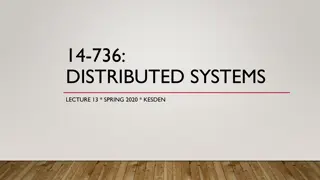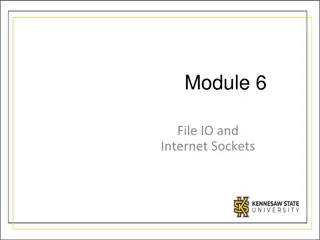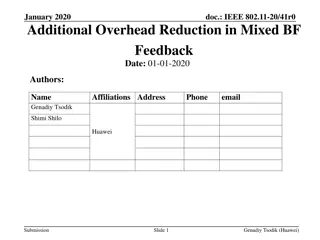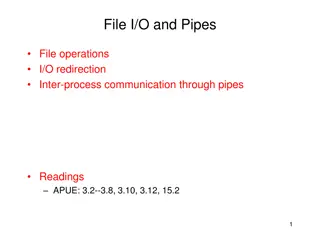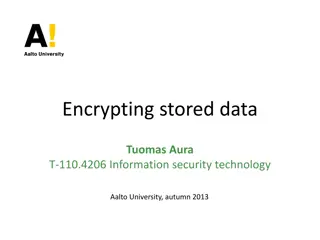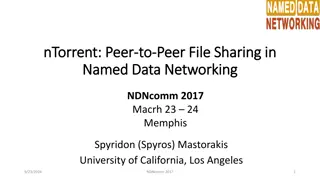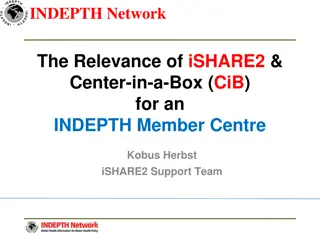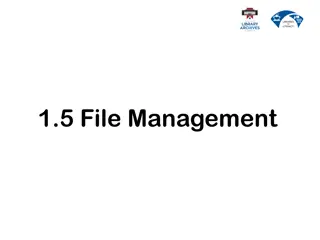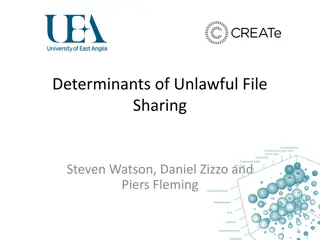Efficient File Size Reduction Strategies for Better Data Management
Discover effective recommendations and examples for reducing file sizes, optimizing service code grouping, and handling provider negotiations within a single TIN. Learn about streamlining processes and maximizing resource utilization in a structured manner.
- Data management
- File size reduction
- Optimization strategies
- Provider negotiations
- Service code grouping
Download Presentation

Please find below an Image/Link to download the presentation.
The content on the website is provided AS IS for your information and personal use only. It may not be sold, licensed, or shared on other websites without obtaining consent from the author. Download presentation by click this link. If you encounter any issues during the download, it is possible that the publisher has removed the file from their server.
E N D
Presentation Transcript
File Size Reduction Recommendations
Various Opportunities Examples/Scenarios To Cover Provider Grouping Service Code Multiple Plans Per File Referenced Provider Groups File Compression Depending on your situation, your mileage may vary
Provider Groups Use-Case: Providers that have negotiated rates for items and services under a single TIN. SQL Pseudocode: SELECT providers GROUP BY tax-id Previous Implementation: Each group of providers by tin had its own negotiated price object
Provider Groups Previous Implementation: Each group of providers by tin had its own negotiated price object Current Implementation: Multiple provider/tin combinations can be associated to negotiated price objects.
Provider Groups What you might be doing What you can do instead "provider_groups": [{ "provider_groups": [{ "npi": [111, 222, 333], "npi": [111, 222, 333, 444, 555, 666], "tin":{ "tin":{ "type": "ein", "type": "ein", "value": "11-1111111" "value": "11-1111111" } } },{ }] "npi": [444, 555, 666], "tin":{ "type": "ein", "value": "11-1111111" } }] Take Away: Group all the providers associated with a single TIN into a single provider group object
Service Code "negotiated_rates": [{ "providers": [111, 222, 333], "tin": "11-1111111", Use-Case: "service_code": "01", "negotiated_price": { Negotiated rates that are service code dependent. "negotiated_type": "negotiated", "negotiated_rate": 12.45, "expiration_date": "2022-01-01" } Previous Implementation: },{ "providers": [111, 222, 333], "tin": "11-1111111", Each service code required a separate negotiated "service_code": "02", price object even if that negotiated price object was "negotiated_price": { "negotiated_type": "negotiated", the same. "negotiated_rate": 12.45, "expiration_date": "2022-01-01" } }]
Service Code Previous Implementation: Current Implementation: "negotiated_rates": [{ "negotiated_prices": [{ "providers": [111, 222, 333], "negotiated_type": "negotiated", "tin": "11-1111111", "negotiated_rate": 123.45, "service_code": "01", "expiration_date": "2022-01-01", "negotiated_price": { "service_code": ["18", "19", "11"], "negotiated_type": "negotiated", "billing_class": "professional" "negotiated_rate": 12.45, }] "expiration_date": "2022-01-01" } }] Take Away: Group all relevant service codes together for the specific negotiated price
Multiple Plans Per File Use-Case: Grouping plans together in a single file that have the same exact negotiated rates for all items and services for the same provider networks. Impact: Avoiding the possibility of producing hundreds of large duplicate files.
Multiple Plans Per File Table Of Contents "reporting_plans": [{ "plan_name": "medicaid", https://www.some_site.com/files/inn-123456.json "plan_id_type": "hios", "plan_id": "11111111111", { "plan_market_type": "individual" "reporting_entity_name": "cms", },{ "reporting_entity_type": "cms", "plan_name": "medicare", "last_updated_on": "2020-08-27", "plan_id_type": "hios", "version": "1.0.0", "plan_id": "0000000000", "in_network": [{...}] "plan_market_type": "individual" } }], "in_network_file": { "description": "in-network file", "location": "https://www.some_site.com/files/inn-123456.json" }, "allowed_amount_file": { "description": "allowed amount file", "location": "https://www.some_site.com/files/aa-987665.json" }
Multiple Plans Per File Take Away: If there are multiple plans that have the exact same negotiated rates for each item and service for each provider network, create a table of contents file that combines the plans and references the in-network or allowed-amount file. This will absolutely decrease the total footprint size of the amount of files that are needed along with the storage needed.
Referenced Provider Groups Use-Case: Large provider groups per TIN. Many different provider groups. Flat File Tweaks: Flat files are typically denormalized views of data. Normalized representations of data are typically found in a database or through (REST) API calls.
Referenced Provider Groups Current Provider Group Implementation (taken from previous slide): "provider_references":[{ "negotiated_rates": [{ "provider_group_id": 1, "provider_groups": [{ "provider_group": { "npi": [111, 222, 333, 444, 555, 666], "npi": [111, 222, 333, 444, 555, 666], "tin":{ "tin":{ "type": "ein", "type": "ein", "value": "11-1111111" "value": "11-1111111" } } },{ } "npi": [999, 888, 777], },{ "tin":{ "provider_group_id": 2, "type": "ein", "provider_group": { "value": "22-2222222" "npi": [999, 888, 777], } "tin": { }], "type": "ein", "negotiated_prices": [{...}] "value": "22-2222222" } } } }]
Referenced Provider Groups "negotiated_rates": [{ "provider_groups": [{ "npi": [111, 222, 333, 444, 555, 666], "tin":{ "provider_references":[{ "type": "ein", "provider_group_id": 1, "value": "11-1111111" "provider_group": { } "npi": [111, 222, 333, 444, 555, 666], },{ "tin":{ "negotiated_rates": [{ "provider_references": [1, 2], "npi": [999, 888, 777], "tin":{ "type": "ein", "value": "11-1111111" "negotiated_prices": [{ "negotiated_type": "negotiated", "type": "ein", "value": "22-2222222" } } "negotiated_rate": 12003.45, } },{ "expiration_date": "2022-01-01", }], "provider_group_id": 2, "service_code": ["18", "19", "11"], "negotiated_prices": [{ "provider_group": { "billing_class": "professional" "negotiated_type": "negotiated", "npi": [999, 888, 777], }] "negotiated_rate": 12003.45, "tin": { } "expiration_date": "2022-01-01", "type": "ein", "service_code": ["18", "19", "11"], "value": "22-2222222" "billing_class": "professional" } }] } Github Implementation Example } }]
Referenced Provider Groups Take Away: Normalize provider groups by defining them on the root object and reference them in the in-network file. Has the potential to reduce file size significantly. Something to pay attention to: If external files are implemented, the normalized provider group schema format would be the same.
File Compression Use-Case: Large uncompressed text files. Common compression formats: .7z, .zip, .tar.gz, .rar, etc Take Away: Text files such as the machine-readable files will benefit greatly from being compressed. This will not only help with storage considerations but also with network bandwidth.








